In the enchanting world of arachnid enthusiasts, a tiny eight-legged creature has been steadily weaving its way into the hearts of many – the jumping spider pet.
These remarkable arachnids belong to a fascinating group of spiders that are rapidly gaining popularity for their unique behaviors, easy care, and surprising intelligence. Due to their diminutive stature, jumping spiders are well-suited for confined environments.
To care for them, provide a suitable habitat, feed live insects, maintain cleanliness, and ensure proper lighting, temperature, and humidity. Join us in this guide to explore the world of jumping spider companionship and discover the charm of these tiny marvels!
Jumping Spiders Pet Characteristics:
Family and Scientific Name: The jumping spider belongs to the Animalia and Salticidae kingdoms. The name “Salticidae” has its roots in the Latin word “saltus,” meaning “jump.” With over 6,000 known species, jumping spiders are the world’s most prominent spider family.
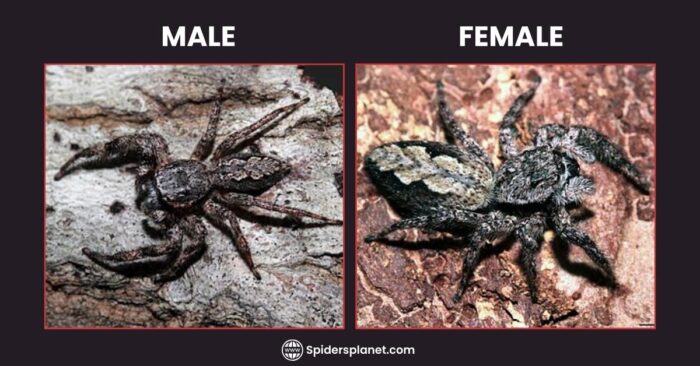
Appearance:
Their unique features make it easy to identify jumping spiders. Their flat-faced heads with large, front-facing eyes give them a distinctive appearance. These eyes provide these tiny spiders with three-dimensional vision in three-dimensionality, making them precise hunters. Additionally, their front legs are designed for grabbing prey, while the smaller hind legs give them the power to execute impressive jumps.
Size:
Measuring between 0.2 to 0.98 inches, jumping spiders, though small in stature, typically span from a few millimeters to around a centimeter.
Color:
Jumping spiders are like little artists with a colorful palette. Some are see-through green, like Onomastus kinoi, while others, like the peacock jumping spider, flaunt vibrant spots and stripes. These tiny acrobats spice up the world with colors like brown, gray, yellow, red, blue, black, white, tan, and green.
Locations:
These nimble arachnids are found across Africa, Asia, Central America, Europe, North America, and South America except Antarctica.
Pet Jumping Spider Habitat:
Jumping spiders, versatile in their habitat choices, live in a variety of environments almost anywhere around the globe, from the lush canopies of tropical and temperate forests to the challenging terrain of mountains, and even the arid expanses of deserts, scrubland, fields, human habitation.
Pet Jumping Spider Lifespan:
Jumping spiders live relatively short but eventful lives, ranging from six months to two years.
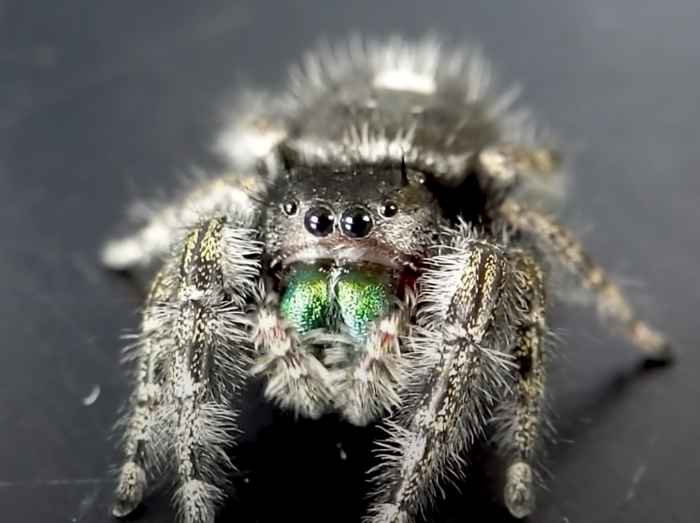
Behavior:
Jumping spiders are like little adventurers in the spider world. They are not only curious and playful but also super intelligent. They can learn and solve problems! These spiders are super hunters, using their sharp eyesight to spot prey and leaping on them with lightning speed. They’re social creatures, forming relationships and even teaming up to build webs and care for their young.
Diet:
Jumping spiders are carnivores, and their diet consists of various insects and other small invertebrates. Their favorite prey include flies, crickets, moths, and other spiders. They have also been known to eat worms, mealworms, waxworms, and even small lizards.
Different Types of Jumping Spiders:
Out of 6000 species, some of the standard and popular types of species are as follows:
| Phidippus | Bold jumper | Phidippus regius | Peacock spider |
| Zebra spider | Tan jumping spider | Plexippus paykulli | Portia |
| Gray wall jumper | Myrmarachne | Maratus | Hispo |
| Salticus | Dendryphantinae | Bagheera kiplingi | Mopsus mormon |
| Evarcha | Marpissa muscosa | Habronattus | Marpissa |
| Salticinae | Heliophanus | Myrmarachne formicaria | Euophrys |
| Phintella | Cosmophasis | Carrhotus xanthogramma | Saitis barbipes |
| Toxeus magnus | Lyssomanes | Aelurillus | Pseudeuophrys |
| Pellenes | Phlegra | Maevia inclemens | Trite |
| Hentzia | Telamonia dimidiata | Siler | Euophryini |
| Icius | Hyllus semicupreus | Anasaitis canosa | Epeus |
| Phiale | Synageles venator | Mago | Manzuma |
| SibianorPseudicius | Euophrys omnisuperstes |
Jumping Spider as Pet:
Nowadays, Jumping spiders are stars on platforms like Instagram, TikTok, and YouTube.
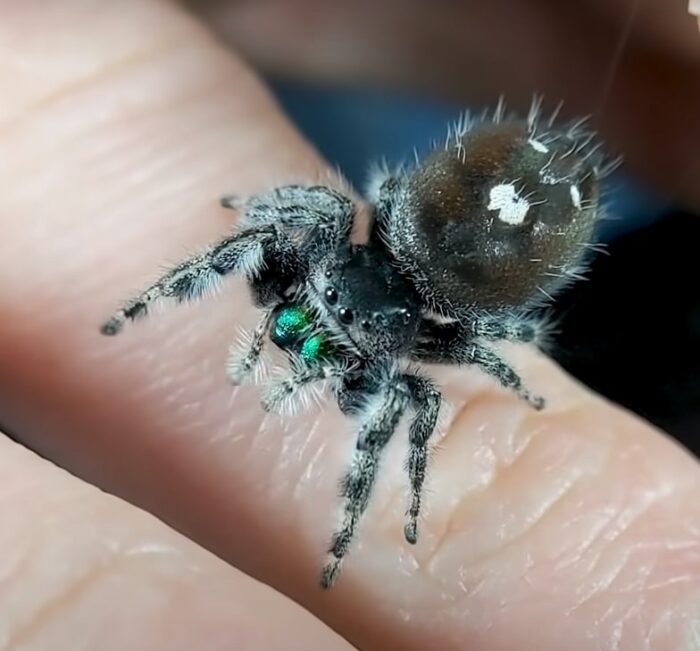
Jumping spiders have become social media sensations, captivating users for a few compelling reasons. Their striking and colorful appearance makes them incredibly photogenic and appealing to a broad audience. Add to that their curious and playful behavior, and you have entertaining content that people love to watch and follow. These intelligent creatures have also benefited from the “bug influencer” trend, where insects take center stage on social media.
Related Post: Grass Spider: Appearance, Habitat, Lifecycle, Preventive Measures
People are actually opting to keep them as pets. There are different types, each with its own care requirements and costs, and the internet is filled with advice on the best spider companions. Let’s explore what it takes to have these cute spiders as pets—you might want one, too!
Why Jumping Spider Pet?
Jumping spiders have gained popularity as pets for several reasons:
Choosing the Right Jumping Spider Companion:
If you are considering a jumping spider as a pet, exploring the various types available is essential. Amongst the most commonly embraced types are:
Regal Jumping Spider (Phidippus regius):
The regal jumping spider is a big and colorful jumping spider pet, with males and females looking different. Females come in various colors, like gray, tan, black, orange, and more, and their markings on the abdomen can look like a heart or a tiki mask.
Bold Jumping Spider (Phidippus audax):
Bold jumping spiders, slightly smaller than regals at 8 to 18 millimeters, have black or grayish females with variable-colored(pinkish, yellow, or orange in color) spots on their backs. Females have fluffy pedipalps, and mature males resemble male regal jumping spiders.
Zebra Jumping Spider (Salticus scenicus):
These tiny jumping spiders, sporting black and white stripes that mimic a zebra’s pattern, these agile hunters boast impressive jumping skills, adding an extra thrill to their behavior.
Heavy Jumping Spider (Hyllus diardi)
The heavy jumping spider is the most giant jumping spider pet, scientifically known as Hyllus diardi, and is an intriguing arachnid. It belongs to the jumping spider family and is recognized for its substantial size and robust build.
Some of the other most popular species for little jumping spider pet are:
Care for your Jumping Spider:
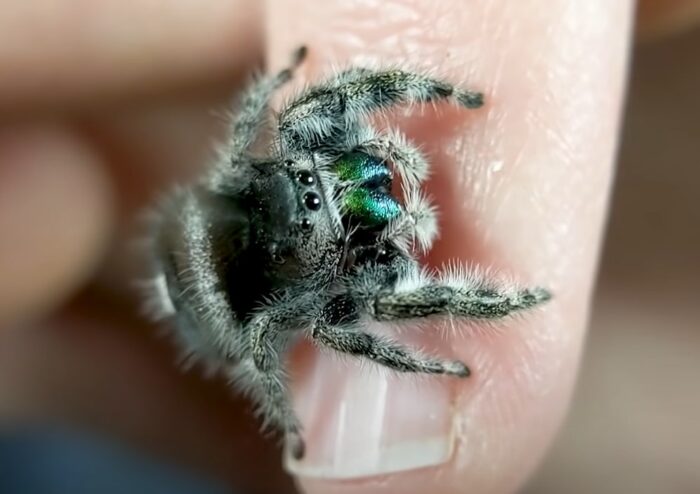
Jumping Spider Pet Enclosure:
Jumping spiders love hanging out in trees and vegetation, so when setting up their home, they must choose an enclosure that allows easy access to the top, where they prefer making their hammocks. Despite their small size, jumping spiders do not need much space. Creating a suitable enclosure for a pet jumping spider is essential for its well-being. Here are some guidelines to help you set up an appropriate habitat:
Spot clean as needed, removing uneaten food or waste. Perform a thorough cleaning every few months.
Temperature and Humidity:
Maintain a temperature between 70-85°F (21-27°C). Jumping spiders usually adapt well to normal household humidity levels. No additional humidity is generally required.
Related Post: Bold Jumping Spider – Your New Adorable & Exciting Pet
Lighting and Heating:
Keep your spider in a well-lit space during the day since they rely on good eyesight for hunting. You can provide light using a fluorescent bulb or a natural light source, such as a window. There is no need for heating; just maintain a room temperature above 10 degrees Celsius in a more relaxed area. Never expose the enclosure to direct sunlight or near heaters, as this can lead to overheating and harm to your spider.
While some jumping spiders tolerate gentle handling, it is generally best to minimize interaction. Always be gentle and avoid stressing the spider.
Remember to thoroughly research your specific species of jumping spider, as there can be some variation in their care requirements. Observing your spider’s behavior and adjusting the habitat is critical to ensuring its well-being.
How do jumping spiders eat?
Now you might be thinking, what do baby jumping spiders eat? Jumping spiders enjoy a variety of prey. For the little ones, like slings, go for flightless fruit flies sized right for them. As they grow, more giant spiders can handle larger meals, such as wax worms, mealworms, crickets, and flies. Watch out for crickets; they have strong jaws that might harm your spider.
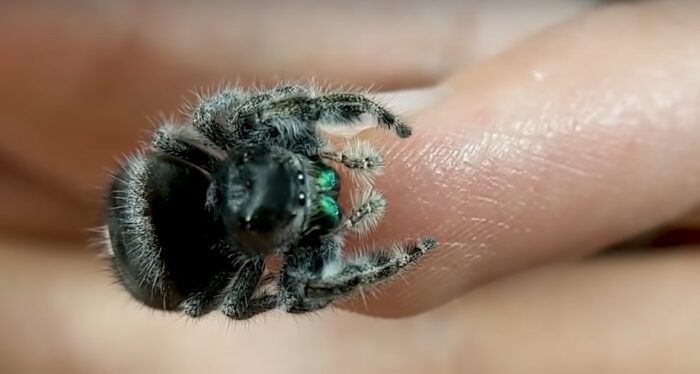
Keep a close eye during feeding, and if your spider isn’t interested, remove the prey. As I said earlier, these cute spiders like a wide range of food, and they can be choosy, so keep 2 to 3 types of food ready, and some can be a bit choosy. Ensure you have feeders prepared before bringing your new spider home, as shipping can be unpredictable, and only some have easy access to feeders locally.
Water:
Make sure your spider has access to water by misting one side of its enclosure daily with a delicate spray bottle. The water droplets should evaporate within an hour or two if humidity is adequate. Be cautious not to overdo it, as spiders breathe through book lungs on the underside of their abdomen, and excess water could lead to drowning. Alternatively, you can use moist paper towels in the enclosures, changing them regularly for hydration.
Molting:
Molting is how jumping spiders grow, shedding their old exoskeleton multiple times throughout their lives. Signs of molting include decreased activity, a halt in eating, building a thick web hammock, and a swollen, opaque abdomen. If your jumping spider is molting, leave it alone, as disturbing it can be fatal.
Care for a molting spider by maintaining humidity through regular misting, providing a safe molting place like a web hammock or hide box, and refraining from feeding until it emerges from the old exoskeleton. After molting, wait for the spider’s new exoskeleton to harden before handling. Once it’s set, gently remove the old exoskeleton. If you have concerns, consult a veterinarian or experienced jumping spider breeder.
Where to get a Jumping Spider Pet?
If you want a jumping spider pet, there are several options to explore. Some pet stores carry jumping spiders, but it is crucial to research and choose a store that sells healthy, captive-bred spiders. Online retailers also offer jumping spiders, so select a reputable one with a live arrival guarantee.
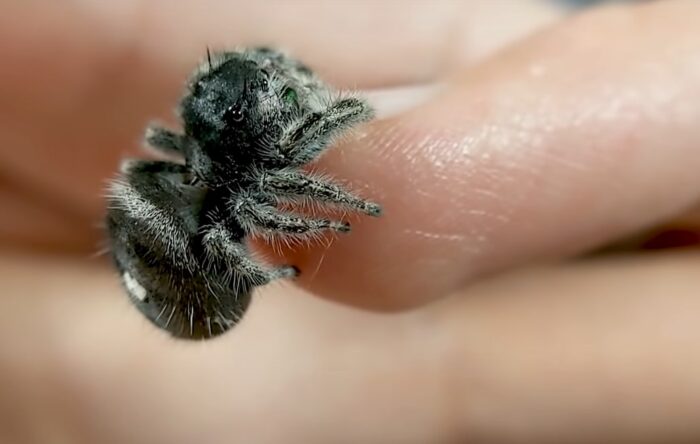
Additionally, consider contacting spider breeders who focus on raising jumping spiders for the pet trade. You can find these breeders online or by contacting local reptile and exotic pet clubs. Doing your homework and choosing a reliable source is vital to ensuring the well-being of your new eight-legged friend.
FAQs:
Can you handle pet-jumping spiders?
Yes, it is possible to handle pet-jumping spiders. They are known for their docile nature and are considered one of the more manageable spider species to keep as pets. Handling can be enjoyable to interact with, but it’s crucial to do so gently and carefully, considering their delicate nature.
Are jumping spiders peaceful?
Yes, jumping spiders are generally peaceful creatures. They are not aggressive and do not bite humans unless they feel threatened or cornered. Jumping spiders are more interested in hunting prey than in interacting with humans.
Can jumping spiders fly?
Jumping spiders don’t fly, but they can “balloon.” They release silk strands caught by the wind, allowing them to travel. This behavior helps them disperse, find mates, or escape predators.
Will jumping spiders fight?
Yes, jumping spiders will fight, but only in certain situations. Male jumping spiders will fight for territory or mating rights, and female jumping spiders will fight each other for food or nesting sites.
Do jumping spiders have memory?
Some studies suggest that jumping spiders have a relatively sophisticated memory system. They can learn and remember information about their environment, which helps them to survive and reproduce.
What is the enemy of the jumping spider?
Jumping spiders have several enemies, including other spiders such as wolf spiders and ground spiders, birds such as wrens, warblers, and flycatchers, and reptiles and amphibians such as lizards, frogs, and toads. Moreover, spider wasps paralyze spiders and drag them to their nests, using them as food for their larvae.
Related Post: Regal Jumping Spider: Expert Care, Breeding, and Price Guide
My Final Thoughts:
The world of pet jumping spiders is a captivating blend of beauty, intelligence, and easy care. From their unique appearance to entertaining behaviors, these arachnids are social media stars.
Choosing the right spider means exploring diverse species and setting up a suitable habitat; understanding feeding habits and proper care ensures a fulfilling experience. With their ability to learn and remember, they are cherished members of the arachnid enthusiast’s world.”




Leave a Reply